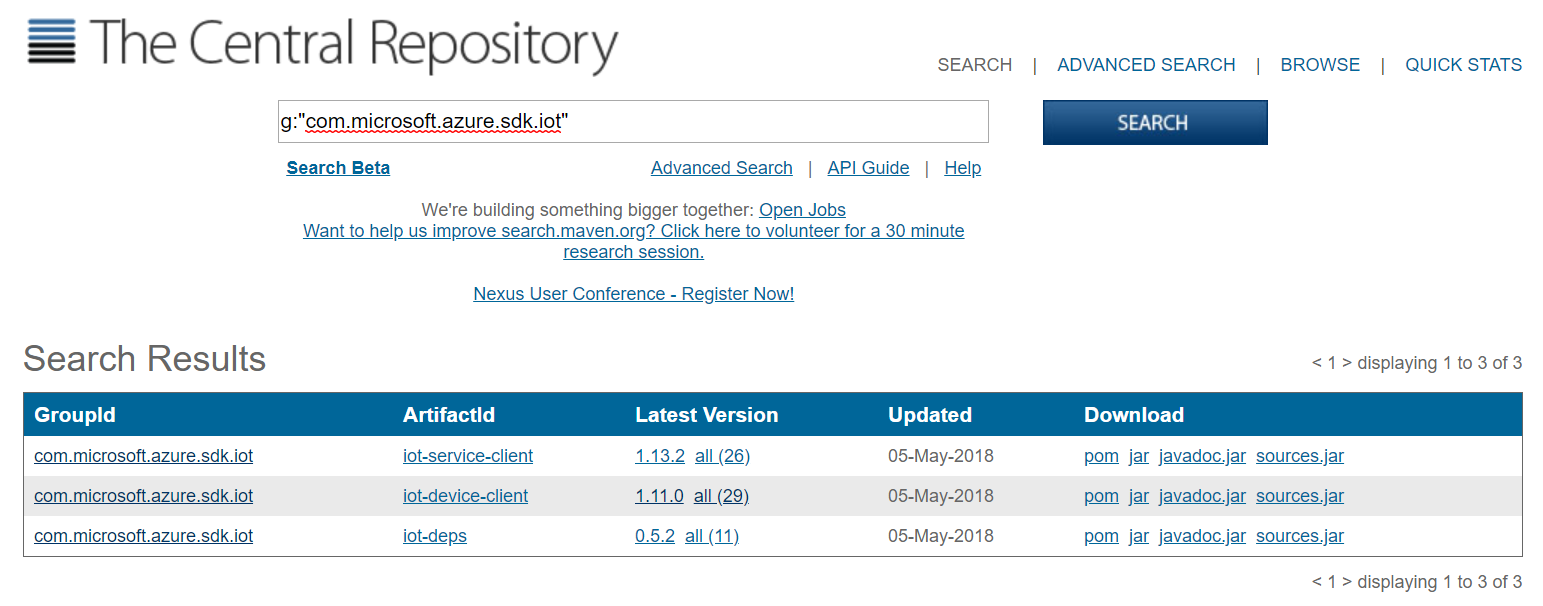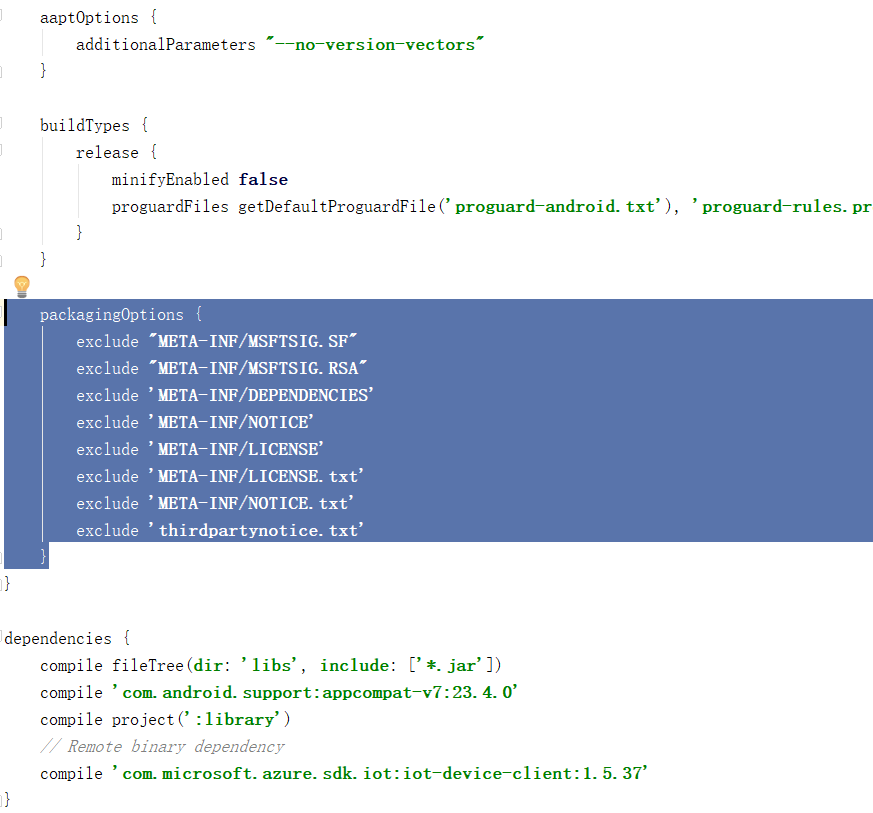Microsoft Azure IoTHub Serials 2 - 如何为android应用添加IoTHub支持
1. 在build.gradle(app)文件的dependencies中添加对以下项的依赖:
'com.microsoft.azure.sdk.iot:iot-device-client:1.5.37'

其中后面的1.5.37是版本号,最新的版本可以到这里查:
http://search.maven.org/#search%7Cga%7C1%7Cg%3A%22com.microsoft.azure.sdk.iot%22

2. 在build.gradle(app)文件的packagingOptions中添加如下内容
packagingOptions { exclude "META-INF/MSFTSIG.SF" exclude "META-INF/MSFTSIG.RSA" exclude 'META-INF/DEPENDENCIES' exclude 'META-INF/NOTICE' exclude 'META-INF/LICENSE' exclude 'META-INF/LICENSE.txt' exclude 'META-INF/NOTICE.txt' exclude 'thirdpartynotice.txt' }
如下图所示。

3. 在需要与IoTHub交互的java文件中,引入如下package
//Azure IoTHub packages import com.microsoft.azure.sdk.iot.device.DeviceClient; import com.microsoft.azure.sdk.iot.device.IotHubClientProtocol; import com.microsoft.azure.sdk.iot.device.IotHubEventCallback; import com.microsoft.azure.sdk.iot.device.IotHubMessageResult; import com.microsoft.azure.sdk.iot.device.IotHubStatusCode; import com.microsoft.azure.sdk.iot.device.Message;
4. 添加如下全局的连接字符串
//Azure IoTHub private final String connString = "HostName=************.azure-devices.net;DeviceId=***********;SharedAccessKey=*********************"; private final String deviceId = "*****************";
5. 在java文件中添加如下3个类(MessageCallbackMqtt、EventCallback、MessageCallback和Counter)的声明
// Our MQTT doesn't support abandon/reject, so we will only display the messaged received // from IoTHub and return COMPLETE static class MessageCallbackMqtt implements com.microsoft.azure.sdk.iot.device.MessageCallback { public IotHubMessageResult execute(Message msg, Object context) { Counter counter = (Counter) context; System.out.println( "Received message " + counter.toString() + " with content: " + new String(msg.getBytes(), Message.DEFAULT_IOTHUB_MESSAGE_CHARSET)); counter.increment(); return IotHubMessageResult.COMPLETE; } } static class EventCallback implements IotHubEventCallback { public void execute(IotHubStatusCode status, Object context) { Integer i = (Integer) context; System.out.println("IoT Hub responded to message " + i.toString() + " with status " + status.name()); } } static class MessageCallback implements com.microsoft.azure.sdk.iot.device.MessageCallback { public IotHubMessageResult execute(Message msg, Object context) { Counter counter = (Counter) context; System.out.println( "Received message " + counter.toString() + " with content: " + new String(msg.getBytes(), Message.DEFAULT_IOTHUB_MESSAGE_CHARSET)); int switchVal = counter.get() % 3; IotHubMessageResult res; switch (switchVal) { case 0: res = IotHubMessageResult.COMPLETE; break; case 1: res = IotHubMessageResult.ABANDON; break; case 2: res = IotHubMessageResult.REJECT; break; default: // should never happen. throw new IllegalStateException("Invalid message result specified."); } System.out.println("Responding to message " + counter.toString() + " with " + res.name()); counter.increment(); return res; } } /** * Used as a counter in the message callback. */ static class Counter { int num; Counter(int num) { this.num = num; } int get() { return this.num; } void increment() { this.num++; } @Override public String toString() { return Integer.toString(this.num); } }
6.需要发送数据时,调用以下代码段
private void SendMessage() throws URISyntaxException, IOException { // Comment/uncomment from lines below to use HTTPS or MQTT protocol // IotHubClientProtocol protocol = IotHubClientProtocol.HTTPS; IotHubClientProtocol protocol = IotHubClientProtocol.MQTT; DeviceClient client = new DeviceClient(connString, protocol); try { client.open(); } catch (Exception e2) { System.err.println("Exception while opening IoTHub connection: " + e2.toString()); } //发送message填充 String msgStr = "{\"deviceId\":\"" + deviceId + ",\"PM25\":" + PM25 + ",\"PM10\":" + PM10 + "}"; try { Message msg = new Message(msgStr); msg.setProperty("PMAlert", PM25 > 100 ? "true" : "false"); msg.setMessageId(java.util.UUID.randomUUID().toString()); System.out.println(msgStr); EventCallback eventCallback = new EventCallback(); client.sendEventAsync(msg, eventCallback, null); } catch (Exception e) { System.err.println("Exception while sending event: " + e.getMessage()); } try { Thread.sleep(2000); } catch (InterruptedException e) { e.printStackTrace(); } client.closeNow(); }
本文版权归作者和博客园共有,欢迎转载,但未经作者同意必须保留此段声明,且在文章页面明显位置给出原文连接,否则保留追究法律责任的权利。



 本文详细介绍了如何为Android应用添加Azure IoTHub支持的流程。
本文详细介绍了如何为Android应用添加Azure IoTHub支持的流程。

 浙公网安备 33010602011771号
浙公网安备 33010602011771号